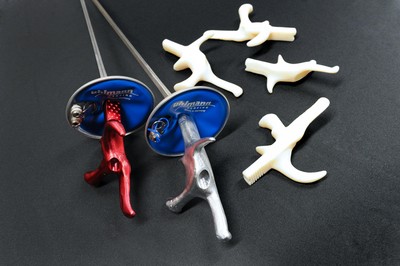MINNEAPOLIS and REHOVOT, Israel, Aug. 27, 2013 — Stratasys Ltd. (NASDAQ: SSYS), a leading manufacturer of 3D printers and production systems for prototyping and manufacturing, today has announced that the University of Tsukuba, Japan is using an Objet350 Connex multi-material 3D Printer as part of its advanced R&D program for sports science and Olympic training.
The University of Tsukuba conducts research and development in three key areas: sports equipment, training and conditioning. A research team led by Professor Norihisa Fujii at the university’s Faculty of Gymnastics developed equipment used by Japan‘s fencing team which won the Silver medal in the 2012 London Olympics.
3D Printing Helps Fencers Get a Grip
The hilt of the fencing sword must fit the fencer’s hand perfectly, even a slight difference in the shape of the hilt can spell victory or defeat. Before 3D printing, there was only one type of fencing hilt in the world, and each competitor had to personally file the hilt to customize the fit and achieve a non-slip surface. If the sword ended up breaking, it was almost impossible to get another one with the same fit.
For the 2012 Olympics the researchers at the University of Tsukuba scanned the actual equipment used by the fencers in 3D, and the resulting polygon data was then incorporated into 3D CAD. The 16-micron accuracy of the PolyJet based Objet350 Connex 3D Printer enabled the researchers to produce iterative prototypes of each sword with minute variations according to the athlete’s feedback. A total of 70 prototypes were produced.
Mr. Osamu Takeda, a researcher who managed the modeling of the prototypes at the University of Tsukuba, Sports R&D Core commented, “Players are not engineers. They talk about their requirements instinctively. So, bearing this in mind, we develop various patterns based on different assumptions. With the Objet Connex multi-material 3D Printer, we can do this easily. We can respond flexibly and promptly because the machine is so accurate,”
The customized, completed hilts were manufactured in April 2012, three months before the London Olympics. For the first time in fencing history, each competitor had five spare hilts, providing a “sense of security.”
“Whatever the sport may be, it’s all about designing customized equipment to enable the athlete to maximize his or her personal best,” said Jon Cobb, Executive Vice President Marketing, Stratasys. “Stratasys 3D printers have a long history with the sports world, spanning everything from the design of customized running shoes to the 3D printing of end use parts for bikes and snowmobiles. The accuracy of our technology and the durability and flexibility of our materials enable sports equipment designers to develop truly breakthrough concepts. Also, the fast turnaround time of 3D printing means that the athlete can try several design iterations until the equipment exactly matches personal preferences.”
The University of Tsukuba is now exploring other 3D printing sports applications such as protective equipment for gymnasts, shoes for javelin throwers, triathlon wear, sailing masts, a footwork assessment system for badminton, and more.
Stratasys Ltd. (Nasdaq: SSYS), headquartered in Minneapolis, Minn. and Rehovot, Israel, manufactures 3D printers and materials for prototyping and production. The company’s patented FDM® and PolyJet® processes produce prototypes and manufactured goods directly from 3D CAD files or other 3D content. Systems include 3D printers for idea development, prototyping and direct digital manufacturing. Stratasys subsidiaries include MakerBot and Solidscape and the company operates the RedEye On Demand digital-manufacturing service. Stratasys has more than 1500 employees, holds over 500 granted or pending additive manufacturing patents globally, and has received more than 20 awards for its technology and leadership. Online at: www.stratasys.comor http://blog.stratasys.com
Cautionary Statement Regarding Forward-Looking Statements
Certain information included or incorporated by reference in this press may be deemed to be “forward-looking statements” within the meaning of the Private Securities Litigation Reform Act of 1995, Section 27A of the Securities Act of 1933, and Section 21E of the Securities Exchange Act of 1934. Forward-looking statements are often characterized by the use of forward-looking terminology such as “may,” “will,” “expect,” “anticipate,” “estimate,” “continue,” “believe,” “should,” “intend,” “project” or other similar words, but are not the only way these statements are identified. These forward-looking statements may include, but are not limited to, statements relating to the company’s objectives, plans and strategies, statements regarding the company’s products and their expected performance, statements that contain projections of results of operations or of financial condition (including, with respect to the MakerBot merger) and all statements (other than statements of historical facts) that address activities, events or developments that the company intends, expects, projects, believes or anticipates will or may occur in the future. Forward-looking statements are not guarantees of future performance and are subject to risks and uncertainties. The company has based these forward-looking statements on assumptions and assessments made by its management in light of their experience and their perception of historical trends, current conditions, expected future developments and other factors they believe to be appropriate. Important factors that could cause actual results, developments and business decisions to differ materially from those anticipated in these forward-looking statements include, among other things: the company’s ability to efficiently and successfully integrate the operations of Stratasys, Inc. and Objet Ltd. after their merger as well as the ability to successfully integrate MakerBot into Stratasys; the overall global economic environment; the impact of competition and new technologies; general market, political and economic conditions in the countries in which the company operates; projected capital expenditures and liquidity; changes in the company’s strategy; government regulations and approvals; changes in customers’ budgeting priorities; litigation and regulatory proceedings; and those factors referred to under “Risk Factors”, “Information on the Company”, “Operating and Financial Review and Prospects”, and generally in the company’s annual report on Form 20-F for the year ended December 31, 2012 filed with the U.S. Securities and Exchange Commission and in other reports that the Company has filed with the SEC. Readers are urged to carefully review and consider the various disclosures made in the company’s SEC reports, which are designed to advise interested parties of the risks and factors that may affect its business, financial condition, results of operations and prospects. Any forward-looking statements in this press release are made as of the date hereof, and the company undertakes no obligation to publicly update or revise any forward-looking statements, whether as a result of new information, future events or otherwise, except as required by law.
Attention Editors, if you publish reader-contact information, please use:
| USA | +1-877-489-9449 |
| Europe/Middle East/Africa | +49-7229-7772-0 |
| Asia Pacific | +852 39448888 |




